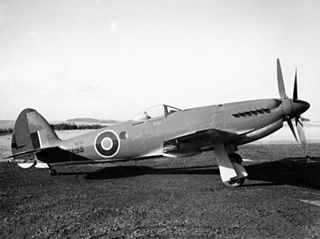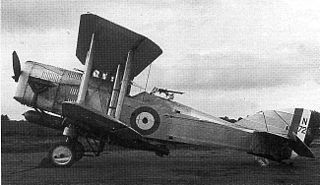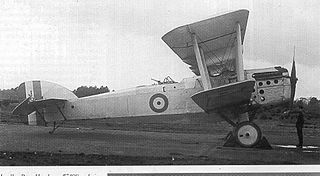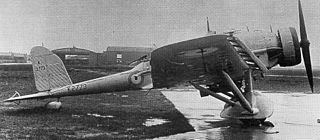Related Research Articles
The Handley Page HP.88 was a British research aircraft, built in the early 1950s for Handley Page to test the aerodynamics of the Victor crescent wing design, and was intended to be a scaled-down version of that aircraft.

The Supermarine Seafang was a British Rolls-Royce Griffon–engined fighter aircraft designed by Supermarine to Air Ministry specification N.5/45. It was based on the Spiteful, which was a development of Supermarine's famous Spitfire aircraft. By that time the Spitfire was a 10-year-old design in a period of rapid technical development in aviation. The Seafang was outmoded by jet aircraft, and only 18 were built.

The Short SA.4 Sperrin was a British jet bomber design of the early 1950s, built by Short Brothers and Harland of Belfast. It first flew in 1951. From the onset, the design had been viewed as a fall-back option in case the more advanced strategic bomber aircraft, then in development to equip the Royal Air Force's nuclear-armed V bomber force, experienced delays; the Sperrin was not put into production because these swept-wing designs, such as the Vickers Valiant, were by then available.

The Blackburn B-3 was a prototype British torpedo bomber designed and built by Blackburn Aircraft as a potential replacement for the Ripon. It was unsuccessful, with only the two prototypes being built.

The Handley Page Hanley was a British torpedo bomber aircraft of the 1920s. A single-engine, single-seat biplane intended to operate from the Royal Navy's aircraft carriers, it was not successful, with only three aircraft being built.

The Handley Page Hendon was a British torpedo bomber of the 1920s. A two-seat development of Handley Page's earlier single-seat Hanley, the Hendon was a single-engine biplane. While six aircraft were purchased by the British Air Ministry for evaluation and trials purposes, no further production ensued and the Hendon did not enter squadron service.

The Short N.1B Shirl was a British single-seat biplane,intended to carry heavy torpedoes from early aircraft carriers late in World War I. It met its specifications but planned production was ended with the Armistice of 1918. The design was developed further for an attempt to cross the Atlantic nonstop for the first time, but this was not successful.

The Gloster TC.33 was a large four-engined biplane designed for troop carrying and medical evacuation in the early 1930s. Only one was built.

The Gloster TSR.38 was a single-engined three-seat biplane designed as a naval torpedo/spotter/reconnaissance aircraft in the early 1930s. It did not reach production and only one was built.

The Bristol Berkeley was built to a British government specification for a single-engine day or night bomber. Three of these two-seat biplanes were built, but no contract for further production was awarded.

The Bristol Type 123 was a single-seat, single-engine biplane fighter built to a United Kingdom Air Ministry specification for a four-gun fighter in the early 1930s. Only one was built.

The Bristol Type 133 was a prototype single-seat, single-engine monoplane fighter, armed with four guns, metal-skinned and with a retractable undercarriage, built by The Bristol Aeroplane Co. to an Air Ministry specification in the mid-1930s. The single example crashed before the trials commenced.

The Vickers Type 207 was a single-engined two-seat biplane designed as a shipborne torpedo bomber to an early 1930s specification. Structurally innovative, only one was built.

The Handley Page Handcross was a single-engined biplane day bomber built to an Air Ministry specification. It was not put into production and only the three prototypes were built.

The Handley Page H.P.47 was a British single-engined low-wing monoplane built to an Air Ministry specification for a general-purpose bomber and torpedo bomber aircraft. Only one was built.

The Handley Page H.P.20 was an experimental monoplane modification of a de Havilland DH.9A, built to study controllable slots and slotted ailerons as high lift devices. It was the first aircraft to fly with controllable slots.

The Handley Page H.P.31 was a two-seat single-engined biplane built to a British specification for a carrier-based torpedo bomber and reconnaissance aircraft. After trials, the Blackburn Ripon was preferred, though the Harrow played a significant role in the development of automatic slots.
The Nakajima B3N was a prototype Japanese carrier-based torpedo-bomber aircraft of the 1930s. A single-engined biplane with a crew of three, it was unsuccessful, only two being built.
The Bristol Type 159 was a British design for a four-engined heavy bomber by the Bristol Aeroplane Company, of Filton, Bristol. A mockup was built but the project was cancelled and no aircraft were built.

The Mitsubishi Ka-12 or B4M was a Japanese carrier-based torpedo bomber of 1934. Two prototypes were built by Mitsubishi for the Imperial Japanese Navy. A development of the company's 3MT10 of 1932, the design differed primarily in the use of a radial engine and metal wing, which made the whole aircraft significantly lighter and faster. However, the design could not realise its potential as the wing was inefficiently stiff and the B4M was not selected for production. The competing Yokosuka B4Y was chosen to serve on the Navy's aircraft carriers instead.
References
Notes
- 1 2 3 4 5 6 Barnes & James 1987 , pp. 328–37
- ↑ Barnes & James 1987 , pp. 334
Bibliography
- Barnes, C.H.; James, D. N. (1987). Handley Page Aircraft since 1907. London: Putnam Publishing. ISBN 0-85177-803-8.